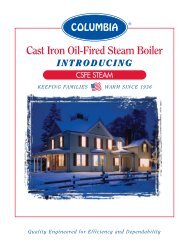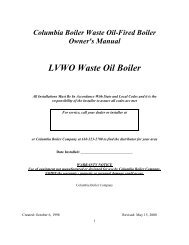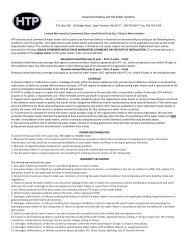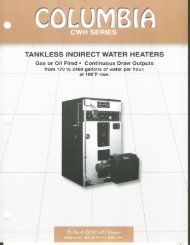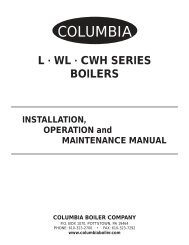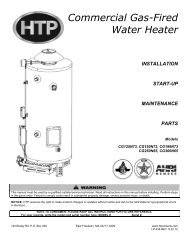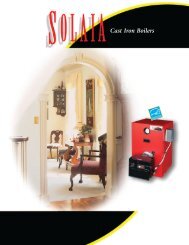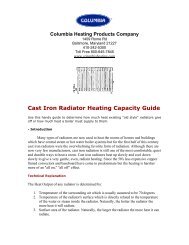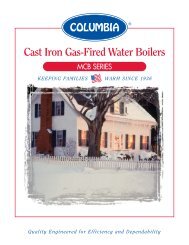CSVB Series II - Columbia Heating
CSVB Series II - Columbia Heating
CSVB Series II - Columbia Heating
- No tags were found...
Create successful ePaper yourself
Turn your PDF publications into a flip-book with our unique Google optimized e-Paper software.
HORIZONTAL VENTING INSTRUCTIONS8. Joining and Sealing the Vent Pipe:The vent pipe needs to be both watertight and gastight. Seal all joints and seams as follows:A. For Z-Flex Z-Vent stainless steel vent pipe usea high temperature silicone sealant rated for550°F. The outside of the male end and insideof the female end of the pipe must be cleanedwith brake cleaner before applying silicone bead.For 3” vent pipe runs begin with the male endof the vent pipe over the boilers induced draftblower outlet. For 4” vent pipe runs begin with a6” length of 3” Z-Vent over the boiler’s induceddraft blower outlet, to which an even bead of hightemperature silicone sealant should be applied.Then connect the 3” Z-Vent to a Z-Vent 3” to 4”reducer. Then continue the 4” Z-Vent pipe run byconnecting the 4” male end of the Z-Vent to thereducer. (A locking band may be used around thisjoint for additional support.) Then following thesealing instructions, push the 4” male end of theZ-Vent over the 4” increaser fitting. When usingthe Tjernlund VH-1 vent hood, the female end(flared end) of the vent pipe will be connected tothe termination hood. The male end of the venthood must be crimped before pushing the Z-Ventover the vent hood’s connecting pipe. Before thepipes are joined, apply a ¼” bead of silicone oneinch from the end of the male end. Then push thepipes together as far as they will go making sureany seams are aligned and oriented upward. Nowapply another bead of silicone around this joint andsmooth out. Then use a Z-Flex locking band aroundthe center of the joint.1. Apply the high temperature siliconeapproximately one inch from the end, aroundthe male end of the pipe in an even ¼” bead.2. Pipes can now be pushed together as far as theywill go. The seams on pipe should be alignedand oriented upward in all horizontal appliances.Apply another bead of silicone around this jointand smooth out.3. Slide locking band over center of joint andtighten gear clamps. Make sure locking band iscentered on joint.4. Check all joints and seams for gas tightness.5. Horizontal venting shall have slope not lessthan ¼” every 12 inches (21mm/m) downwardaway from the boiler to prevent collection ofcondensate throughout the assembly.6. Allow sealant to cure for 24 hours beforeoperating appliance.B. For Heat-Fab Saf-T-Vent stainless steel vent pipeuse a high temperature silicone sealant rated for550°F The outside of the male end and insideof the female end of the pipe must be cleanedbefore applying the silicone bead. For 3” ventpipe runs, the male end of the vent pipe whichgoes over the outlet of the boiler’s induced draftblower must be crimped. The vent pipe should becrimped as minimal as possible to provide a tightfit over the outlet. After crimping is completed followthe instructions for applying silicone sealant.For 4” vent pipe runs, begin with a Saf-T-Vent 3”to 4” increaser fitting over the boiler’s induceddraft blower outlet, to which an even bead of hightemperature silicone sealant should be applied.Then continue the 4” Saf-T-Vent pipe run by connectingthe 4” male end of the Saf-T-Vent to theincreaser. (A locking band may be used around thisjoint for additional support.) The vent flow must bein the direction indicated on the vent pipe. Whenusing the Tjernlund VH-1 vent hood, the femaleend (flared end) of the vent pipe will be connectedto the termination hood. Apply high temperaturesilicone in an even ¼” bead approximately ¼” to⅜” from the end of the vent hood’s connectingvent pipe. Also, run a similar size bead of siliconesealant down the seam weld of the vent pipe. Thenpush the female end over the vent hood’s connectingvent pipe.1. Apply the high temperature silicone aroundthe male end of the pipe (without the tabs)in an even ¼” bead. Silicone bead should beapproximately ¼” to ⅜” from the end of themale end. Also, run a similar size bead ofsilicone sealant down the seam weld at the endof each joint.2. Pipes can now be pushed together as far as theywill go. The seams on the vent pipe should bealigned and oriented upward in all horizontalappliances. With a moistened finger or flat tool,spread any sealant that squeezes out around thecircumference of the joint.3. Attach the sections together with the lockingrings and tabs (except at the blower outletwhere no locking ring exists.) Inspect thejoint to ensure that flue gases will not leak. Ifnecessary apply additional sealant around thejoint.4. Horizontal venting shall have a slope not lessthan ¼” every 12 inches (21mm/m) downwardaway from the boiler to prevent collection ofcondensate throughout the assembly.5. Allow the sealant to cure for 24 hours beforeoperating the appliance.16



